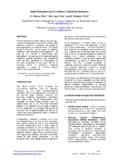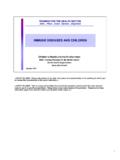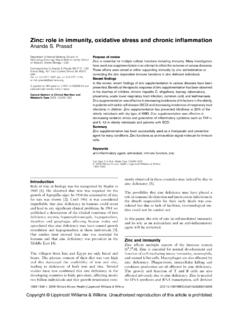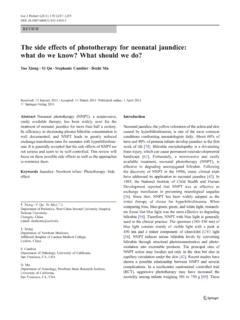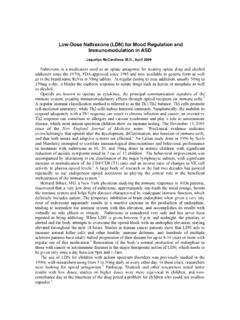Transcription of Sample Quantitative Research Proposal Published by ...
1 Sample Quantitative Research Proposal Published by Permission of the Author Dissertation Proposal Christina Ross PhD(c). Topic: Energy Medicine INTRODUCTION. Inflammation plays a pivotal role in the tissue regeneration process. In addition, therapeutic approaches for tissue regeneration, such as implantation of engineered tissue, often cause additional inflammation. Inflammation is the activation of the immune system in response to infection, irritation or injury. It is characterized by an influx of white blood cells, redness, heat, swelling, and the dysfunction of the organs involved. Despite the important role that inflammation plays, it is insufficiently understood. Commonly, pharmaceutical approaches are used to suppress it, though there is evidence that suppressing inflammation can hinder wound healing [1, 2]. Interest in magnetic field (MF) therapy has increased rapidly in recent years (Figure 1) as Research shows that this non-invasive, cost effective modality might be safer than drugs and surgical procedures for reduction of inflammation.
2 Immunological studies show that MF, even low-intensity MF, can interact with cells and tissues [3-5]. There are various types of magnetic fields, such as static and time-varying, as well as continuous and pulsed, with a wide range of frequencies. Most doses of time-varying and pulsed magnetic field therapies run between 1 100. Hertz (Hz), with ranges of intensity between 1 micro-Tesla ( T) 30 mTesla (mT) (Table 1). Durations of treatments vary between 10 minutes to 48 hours with a number of treatments varying between 10 sessions spaced over several weeks up to six months, depending on the condition [6, 7]. Preliminary data has demonstrated that magnetic field has the ability to affect inflammatory response by affecting cytokine signaling and thereby reducing pro-inflammatory cytokine expression and increasing anti-inflammatory cytokine expression (Figure 2 and 3). Literature shows that IL-1a, IL-1b, IL-6 and TNF- (pro-inflammatory cytokines) and IL-10.
3 (anti- inflammatory cytokine) tend to show the highest numbers of cytokine expression when induced with LPS [8, 9]. 1. SPECIFIC AIMS. In reaction to tissue trauma or pathogen invasion, macrophages respond rapidly to sites of injury initiating an inflammatory response. This migration leads to the destruction of the invading pathogen and eventually wound repair; however, when the control mechanisms go off course, the inflammatory response can become chronic resulting in persistent pain, swelling and eventually tissue damage [10]. Current therapies have shown inefficacies and serious side effects [11] therefore, we setup to explore non-pharmaceutical approaches to controlling inflammation which would aid in tissue regeneration. The aim of this study is to apply a magnetic field to Gram-negative bacteria lipopolysaccharide (LPS) challenged macrophages in order to affect cell cytokine signaling and thereby reduce pro-inflammatory cytokine expression and increase anti-inflammatory cytokine expression.
4 Specific Aim 1 will investigate the inflammatory response by using a well established model of LPS challenged RAW murine macrophages and determining time points of the LPS. inflammatory response, creating a well defined curve with maximum and minimum time points. We will determine LPS dosages to the inflammatory response, creating a well defined curve with maximum and minimum dosages, and assess intensities of cytokine signaling responses with respect to the dosage and time points. Specific Aim 2 will investigate the effects of applying a 25 Hz time varied static magnetic field to the LPS induced RAW murine macrophages in order to affect their cytokine signaling, to thereby reduce pro-inflammatory cytokine expression, and increase anti-inflammatory expression. A multi-analyte ELISAs for those cytokines IL-1 , IL-1 , IL-6, IL-10 and TNF- . will be used to determine the concentration of cytokines that are expressed. Specific Aim 3 will involve the use of an engineered Helmholtz Coil to produce various magnetic field strengths (from 0 to 40 Gauss) as well as use multiple frequencies ranging from 0.
5 To 30 Hz. Once the expression of pro-inflammatory cytokine IL-6 and anti-inflammatory cytokine IL-10 has been shown to be significant, then individual ELISAs for those specific 2. cytokines will be used to determine the concentration of cytokines that are expressed. Standard curves will be established for each. Research STRATEGY. Clinical Relevance Inflammation is known to be the cause of many autoimmune diseases, including Arthritis [12], Multiple Sclerosis [13] , Septic Shock [14] IBS [16], Lupus [15], Juvenile Diabetes [16], as well as Alzheimer's [17]. Statistics show medications for inflammation problems are seen in all demographic groups. Over million American children alone are now taking pills for Type 2. diabetes, sleeping problems, sinus infections and gastro-intestinal problems such as heartburn. Current Treatment Options Current therapies aim to bring the body back into balance with pharmaceutical treatments which can cause adverse side effects such as non-steroidal anti-inflammatory drugs (NSAIDs), which have an analgesic dose ceiling, can cause gastric bleeding, renal toxicity, cardiovascular concerns, occasional central nervous system effects including loss of short-term memory and decreased attention span [18].
6 Other treatment options include heat therapy, which may be applied to the body's surface or to deep tissues. Hot packs, infrared heat, paraffin (heated wax). baths, and hydrotherapy are inexpensive and easily accessible methods of treatment, but too much heat can run the risk of burns [19]. Cold therapy is dosed in the form of ice packs in direct contact with the skin. When ice is applied, it lowers the skin temperature and helps to reduce swelling and inflammation, but ice can also numb nerve endings stopping the transfer of impulses to the brain that register as pain. Although readily available, if not closely monitored, ice can cause frost bite or cell necrosis [20]. In contrast, magnetic therapies have a major advantage over pharmaceuticals because they are more affordable, more easily obtainable, and have very few side effects [21]. 3. Magnetic Field Therapy as an Anti-Inflammatory The earliest use of magnetic field therapy was by Paracelsus, a Swiss physician and alchemist, who over 500 years ago wondered if diseases could be manipu-lated by static magnets called lodestones.
7 Pulsed electromagnetic field stim-ulation began to be studied after Gauss, Weber and Faraday pioneered the study of such events in physics. Magnetic fields are prominent in the Earth's atmosphere, and many argue are essential for human health. For the past two hundred years, it has been possible to build electromagnets from coils of wire powered by electricity. Such devices can be pulsed to produce magnetic fields that change very rapidly. This opens a whole new world of medical applications since changing magnetic fields can induce tiny electrical currents in human tissue [22-25]. Results of this treatment can reduce pain and the onset of edema shortly after trauma. Where edema is already present, this treatment exhibits significant anti-inflammatory effects. Strong beneficial effects have occurred in patients suffering from fractures of the ankle joints [26]. Not only is the inflammatory response present in edema, it is also present in traumatic wound and tissue trauma where magnetic field exposure inhibits inflammation significantly [27].
8 In PEMF therapies, the frequencies used are often times in the extra-low frequency (ELF) range [28] which is between 0 and 30 Hz. C. APPROACH. Preliminary Data Previous studies have developed a reproducible method for the induction and inflammation of murine macrophages with lipopolysaccharide (LPS) [29]. Trace amounts of LPS have been shown to activate the immune system through the toll-like receptor 4 (TLR4), which leads to the production of numerous pro-inflammatory mediators, such as IL-1, IL-6 and TNF- as well as anti-inflammatory cytokine IL-10. 1) Qualitative Assessment of Inflammatory Response After a 12 hour starvation period, cells will be induced with l, 3 l, 5 l and 8 l serial concentrations of lipopolysaccharide (LPS) for one hour. The supernatant will then be aspirated and the cell Sample lysed. The cell lysate will be used as extract for the detection of Nuclear 4. Factor kappa B (NFkB) for subunit p 65 in a transcription factor assay.
9 The p 65 (RelA) subunit provides the gene regulatory function. NFkB is retained in the cytoplasm along with inhibitor kappa B (IkB). Once NFkB binds to the DNA sequence, then a chemiluminescence substrate detects cytokine signals with a luminometer. Results will used to determine peak inflammatory dosage after LPS induction period. 2) Magnetic Field Exposure The cultured LPS induced RAW murine macrophages will be divided into control and SMF-exposed groups then incubated inside two identical incubators. Specific Aim 2 will apply a 25 Hz time-varied static magnetic field device for one hour time exposure. Specific Aim 3 will apply a pulsed electromagnetic field (PEMF) device at various frequencies between 0 and 30 Hz. 3) Qualitative Assessment of Cytokine Signaling All groups will be measured using a Mouse Inflammatory Cytokines Multi-Analyte ELISA rray Kit. The Mouse Inflammatory Cytokines & Chemokines Multi-Analyte ELISA rray Kit analyzes a panel of 12 pro-inflammatory cytokines using a conventional ELISA protocol all at once under uniform conditions.
10 The cytokines & chemokines represented by this array are IL-1 , IL-1 , IL- 2, IL-4, IL-6, IL-10, IL-12, IL-17A, IFN- , TNF- , G-CSF, and GM-CSF. STATISTICAL ANALYSIS. All experimental runs will be tripled in Specific Aims 2 and 3. A cell count using a hemocytometer will be done on each Sample of isolated cells so the data can be normalized if necessary. Numerical data obtained from the ELISAs will be reported as mean +/- standard error of the mean (SEM). Statistical significance between treatment groups will be determined using a one-way analysis of variance (ANOVA) with Tukey's post hoc test. EXPECTED RESULTS, POTENTIAL PROBLEMS AND POSSIBLE SOLUTIONS. We anticipate that magnetic fields will penetrate the surface of the cell plates with out interference or dampening. We have set up a means for measuring this effect using a Hall Effect 5. sensor inside the culture dishes to determine what, if any magnetic field differences may be detected inside and outside the plates.
